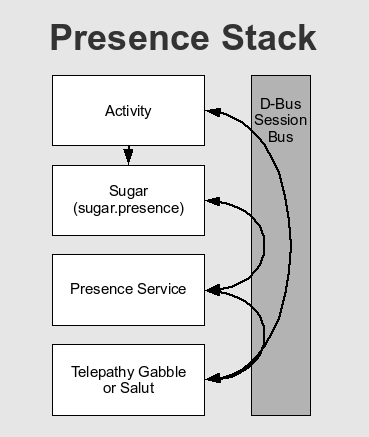Presence Service: Difference between revisions
No edit summary |
No edit summary |
||
| Line 68: | Line 68: | ||
== Release process == |
== Release process == |
||
* Bump version in configure.ac |
* Bump version in configure.ac |
||
* git commit configure.ac -m "version $VERSION" |
|||
* git tag "$VERSION" |
|||
* Make distcheck |
* Make distcheck |
||
* Upload the tarball to dev.laptop.org:/var/www/sugar/sources/sugar-presence-service |
* Upload the tarball to dev.laptop.org:/var/www/sugar/sources/sugar-presence-service |
||
* Update sugar-presence-service rpm package as explained on https://fedoraproject.org/wiki/PackageMaintainers/UpdatingPackageHowTo |
* Update sugar-presence-service rpm package on the OLPC-2 branch as explained on https://fedoraproject.org/wiki/PackageMaintainers/UpdatingPackageHowTo |
||
Revision as of 11:25, 23 April 2008
Overview
The Presence Service is a D-Bus service on the XO that coordinates activity sharing. It uses Telepathy to access the network. It provides information about other people on the network and what activities they are participating in. It is responsible for initiating Telepathy connections when the XO is turned on, reconnecting Telepathy connections when they are disconnected, and registering the laptop with the Jabber server.
Sugar provides a wrapper interface to the D-Bus API in the Python module sugar.presence.
Sugar's “neighborhood view” (or “mesh view”) uses the Presence Service to show who is online (“present”). This performs a function similar to that of a buddy list in a conventional instant messaging application.
See Shared Sugar Activities for an overview of collaboration, or Tubes Tutorial for how to add collaboration to an activity.
Presence stack
Python activities (and Sugar) make use of the sugar.presence module to interact with Presence Service. sugar.presence provides an API for accessing Presence Service over the D-Bus session bus.
Presence Service in turn interacts with Gabble and Salut over the session bus, and once everything is set up (or in the case of non-Python activities) the activity can use Telepathy directly (for example, to use Tubes).
Connection types
Presence Service supports two Telepathy backends (connection managers):
- Telepathy Gabble, that provides server-based Jabber/XMPP functionality. It talks to a Jabber server (e.g. olpc.collabora.co.uk) and sets up different chat rooms through which activities talk to each other.
- Telepathy Salut, a link-local Connection Manager using reliable multicast over the local network
Although Telepathy hides the differences between the protocols, the Presence Services varies its behaviour a little according to which connection it is using. To achieve this, it internally uses a plugin structure, where each type of connection used has an associated plugin.
Only one connection manager is used at a time. The Presence Service will use Gabble when it has Internet access (a valid IPv4 address) and has connected to a Jabber server, otherwise Salut.
Active connection
Though Presence Service is designed to run both connection managers simultaneously, at this stage only one is in effect at a time, since there is no UI support for showing which activities are shared on which connection.
Presence Service will use Gabble when it has Internet access (a valid IPv4 address) and has connected to a Jabber server, otherwise Salut (but not both at the same time). Here is the sequence of events:
- Both plugins are started when Presence Service starts, unless PRESENCE_SERVICE_DEBUG=disable-gabble or disable-salut are set.
- Salut succeeds faster than Gabble, so link local buddies are shown first.
- PS's server plugin watches Network Manager signals on the D-Bus system bus.
- When NM indicates that we have a valid IPv4 address, we run the _init_connection method of the ServerPlugin instance.
- Gabble is automatically run by the session bus (dbus-daemon) via service activation, the first time the Presence Service uses it, if it isn't already running.
- If the Gabble connection fails, we schedule a timer (starting at 5 seconds with exponential backoff to a maximum of 5 minutes) and retry running _init_connection when the timer runs out.
- (classes TelepathyPlugin and ServerPlugin, methods _init_connection, _reconnect_cb, _could_connect, _handle_connection_status_change.)
- If the server plugin has connected to a jabber server, PS stops the link local plugin (salut). Link local buddies disappear.
- If NM loses the IP address, the server plugin stops itself.
- When the server plugin stops, PS starts the link local plugin.
API
Python code can use the sugar.presence library to talk to Presence Service. Non-python code can use the API that Presence Service provides over the D-Bus session bus.
See Low-level Activity API#Presence for the basic operations, and Presence Service DBus API for a more comprehensive, but out of date, API listing.
Source
Browse: http://dev.laptop.org/git?p=projects/presence-service;a=summary
Clone:
git clone git://dev.laptop.org/projects/presence-service
Release process
- Bump version in configure.ac
- git commit configure.ac -m "version $VERSION"
- git tag "$VERSION"
- Make distcheck
- Upload the tarball to dev.laptop.org:/var/www/sugar/sources/sugar-presence-service
- Update sugar-presence-service rpm package on the OLPC-2 branch as explained on https://fedoraproject.org/wiki/PackageMaintainers/UpdatingPackageHowTo
